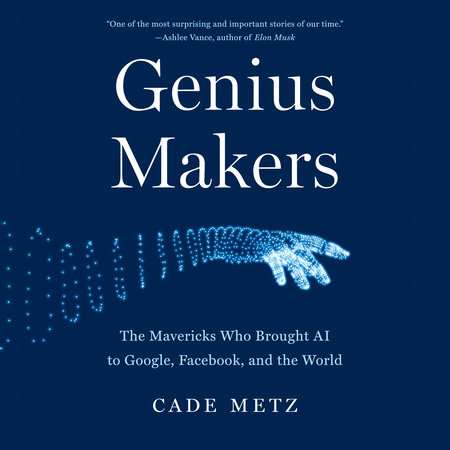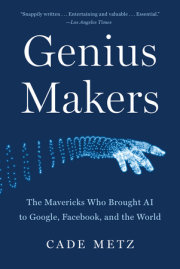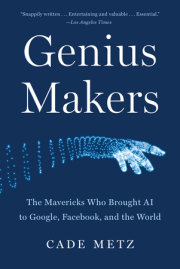1. Genesis
"Frankenstein Monster Designed by Navy That Thinks."
On July 7, 1958, several men gathered around a machine inside the offices of the United States Weather Bureau in Washington, D.C., about fifteen blocks west of the White House. As wide as a kitchen refrigerator, twice as deep, and nearly as tall, the machine was just one piece of a mainframe computer that fanned across the room like a multipiece furniture set. It was encased in silvery plastic, reflecting the light from above, and the front panel held row after row of small round lightbulbs, red square buttons, and thick plastic switches, some white and some gray. Normally, this $2 million machine ran calculations for the Weather Bureau, the forerunner of the National Weather Service, but on this day, it was on loan to the U.S. Navy and a twenty-nine-year-old Cornell University professor named Frank Rosenblatt.
As a newspaper reporter looked on, Rosenblatt and his Navy cohorts fed two white cards into the machine, one marked with a small square on the left, the other marked on the right. Initially, the machine couldn't tell them apart, but after it read another fifty cards, that changed. Almost every time, it correctly identified where the card was marked-left or right. As Rosenblatt explained it, the machine had learned this skill on its own, thanks to a mathematical system modeled on the human brain. He called it a Perceptron. In the future, he said, this system would learn to recognize printed letters, handwritten words, spoken commands, and even people's faces, before calling out their names. It would translate one language into another. And in theory, he added, it could clone itself on an assembly line, explore distant planets, and cross the line from computation into sentience.
"The Navy revealed the embryo of an electronic computer today that it expects will be able to walk, talk, see, write, reproduce itself, and be conscious of its existence," read the article that appeared the next morning in the New York Times. A second article, in the Sunday edition, said that Navy officials hesitated to call this a machine because it was "so much like a human being without life." Rosenblatt grew to resent the way the popular press covered the event, particularly a headline in Oklahoma ("Frankenstein Monster Designed by Navy That Thinks"). In later years, among colleagues and in his published writings, he described the project in more measured terms. He insisted it was not an attempt at artificial intelligence, and he acknowledged its limitations. Still, the idea slipped from his grasp.
The Perceptron was one of the first neural networks, an early incarnation of the technology Geoff Hinton would auction to the highest bidder more than fifty years later. But before it reached that $44 million moment, let alone the extravagant future predicted across the pages of the New York Times in the summer of 1958, it descended into academic obscurity. By the early 1970s, after those lavish predictions met the limitations of Rosenblatt's technology, the idea was all but dead.
Frank Rosenblatt was born on July 11, 1928, in New Rochelle, New York, just north of the Bronx. He attended Bronx Science, the elite public high school that eventually produced eight Nobel laureates, six Pulitzer Prize winners, eight National Medal of Science winners, and three recipients of the Turing Award, the worldÕs top computer science prize. A small, thin man with fleshy jowls and short, dark, wavy hair who wore standard-issue black-rimmed glasses, Rosenblatt was trained in psychology, but his interests were much wider. In 1953, the New York Times published a small story describing an early computer he used to crunch data for his PhD thesis. Called EPAC-short for electronic profile-analyzing computer-it analyzed the psychological profiles of his patients. As the years passed, he came to believe that machines could provide an even greater understanding of the mind. After finishing his PhD, he joined the Cornell Aeronautical Laboratory in Buffalo, about a hundred and fifty miles from the universityÕs main campus in Ithaca, New York. Donated to Cornell by a company that designed aircraft during the Second World War, this flight research center morphed into a more eclectic lab in the postwar years, operating with little oversight from the administration back in Ithaca. It was here that Rosenblatt designed the Perceptron, backed by funding from the Office of Naval Research.
Rosenblatt saw the project as a window into the inner workings of the brain. If he could re-create the brain as a machine, he believed, he could plumb the mysteries of what he called "natural intelligence." Drawing on ideas initially proposed by two researchers at the University of Chicago a decade earlier, the Perceptron analyzed objects and looked for patterns that could identify these objects (for example, whether a card had a mark on the left-hand or right-hand side). It did this using a series of mathematical calculations that operated (in a very broad sense) like the network of neurons in the brain. As the Perceptron examined and tried to identify each object, it got some right and others wrong. But it could learn from its mistakes, methodically adjusting each of those mathematical calculations until the mistakes were few and far between. Much like a neuron in the brain, each calculation was nearly meaningless on its own-just an input for a larger algorithm. But the larger algorithm-a kind of mathematical recipe-could actually do something useful. Or at least that was the hope. At the Weather Bureau in the summer of 1958, Rosenblatt showed off the beginnings of this idea-a simulation of the Perceptron that ran on the bureau's IBM 704, the leading commercial computer of the day. Then, back at the lab in Buffalo, working alongside a team of engineers, he began building an entirely new machine around the same idea. He called it the Mark I. Unlike other machines of the day, it was designed to see the world around it. "For the first time, a non-biological system will achieve an organization of its external environment in a meaningful way," he told a reporter later that year, during another trip to meet with his backers in Washington.
His primary collaborator at the Office of Naval Research did not view the Perceptron in the same extravagant terms. But Rosenblatt was unmoved. "My colleague disapproves of all the loose talk one hears nowadays about mechanical brains," he told the reporter, over a cup of coffee. "But that is exactly what it is." A small, silver pitcher of cream sat on the table in front of him, and he picked it up. Though this was the first time he'd laid eyes on the pitcher, Rosenblatt said, he could still recognize it as a pitcher. The Perceptron, he explained, could do much the same. It could draw the conclusions needed to distinguish, say, a dog from a cat. He admitted that the technology was a long way from having practical uses: It lacked depth perception and "the refinements of judgment." But he was confident of its potential. One day, he said, the Perceptron would travel into space and send its observations back to Earth. When the reporter asked if there was anything the Perceptron was not capable of, Rosenblatt threw up his hands. "Love. Hope. Despair. Human nature, in short," he said. "If we don't understand the human sex drive, how should we expect a machine to?"
That December, the New Yorker hailed Rosenblatt's creation as the first serious rival to the brain. Previously, the magazine had marveled that the IBM 704 could play a game of chess. Now it described the Perceptron as an even more remarkable machine, a computer that could achieve "what amounts to human thought." Though scientists claimed that only biological systems could see, feel, and think, the magazine said, the Perceptron behaved "as if it saw, felt, and thought." Rosenblatt had not yet built the machine, but this was dismissed as a minor obstacle. "It is only a question of time (and money) before it comes into existence," the magazine said.
Rosenblatt completed the Mark I in 1960. It spanned six racks of electrical equipment, each the size of a kitchen fridge, and it plugged into what seemed to be a camera. This was a camera, though engineers had removed the film loader, swapping in a small square device covered with four hundred black dots. These were photocells that responded to changes in light. Rosenblatt and his engineers would print block letters on squares of cardboard-A, B, C, D, etc.-and when they placed these squares on an easel in front of the camera, the photocells could read the black lines of the letters against the white space of the cardboard. As they did, the Mark I learned to recognize the letters, much like the IBM mainframe inside the Weather Bureau learned to recognize the marked cards. This required a little help from the humans in the room: As it worked to identify the letters, a technician would tell the machine whether it was right or wrong. But eventually, the Mark I would learn from its own hits and misses, pinpointing the patterns that identified the slanted line of an A or the double curve of a B. When demonstrating the machine, Rosenblatt had a way of proving this was learned behavior. He would reach into the racks of electrical equipment and pull out a few wires, breaking the connections between the motors that acted as faux-neurons. When he reconnected the wires, the machine once again struggled to recognize the letters, but then, after examining more cards and relearning the same skill, it worked as it did before.
This electrical contraption worked well enough to attract interest beyond the Navy. Over the next several years, the Stanford Research Institute, or SRI, a lab in Northern California, began exploring the same ideas, and Rosenblatt's own lab won contracts with both the U.S. Postal Service and the Air Force. The Postal Service needed a way of reading addresses on envelopes, and the Air Force hoped to identify targets in aerial photos. But all that was still in the future. Rosenblatt's system was only marginally effective when reading printed letters, a relatively simple task. As the system analyzed cards printed with the letter A, each photocell examined a particular spot on the card-say, an area near the lower right-hand corner. If the spot was black more often than white, the Mark I assigned it a high "weight," meaning it would play a more important role in the mathematical calculation that ultimately determined what was an A and what wasn't. When reading a new card, the machine could recognize an A if most of the highly weighted spots were colored black. That was about it. The technology wasn't nearly nimble enough to read the irregularities of handwritten digits.
Despite the system's obvious deficiencies, Rosenblatt remained optimistic about its future. Others, too, believed the technology would improve in the years to come, learning more complex tasks in more complex ways. But it faced a significant obstacle: Marvin Minsky.
Frank Rosenblatt and Marvin Minsky had been contemporaries at Bronx Science. In 1945, MinskyÕs parents moved him to Phillips Andover, the model American prep school, and after the war, he enrolled at Harvard. But he complained that neither could match his experience at Science, where the coursework had been more challenging and the students more ambitious-Ópeople you could discuss your most elaborate ideas with and no one would be condescending,Ó he said. After Rosenblatt died, Minsky pointed to his old schoolmate as the kind of creative thinker who walked the halls of Science, and like Rosenblatt, Minsky was a pioneer in the field of artificial intelligence. But he viewed the field through a different lens.
As an undergraduate at Harvard, using over three thousand vacuum tubes and a few parts from an old B-52 bomber, Minsky built what may have been the first neural network, a machine he called SNARC. Then, as a graduate student in the early '50s, he continued to explore the mathematical concepts that eventually gave rise to the Perceptron. But he came to see artificial intelligence as a larger endeavor. He was among the small group of scientists who crystalized AI as its own field of study during a gathering at Dartmouth College in the summer of 1956. A Dartmouth professor named John McCarthy had urged the wider academic community to explore an area of research he called "automata studies," but that didn't mean much to anyone else. So he recast it as artificial intelligence, and that summer, he organized a conference alongside several like-minded academics and other researchers. The agenda at the Dartmouth Summer Research Conference on Artificial Intelligence included "neuron nets," but also "automatic computers," "abstractions," and "self-improvement." Those who attended the conference would lead the movement into the 1960s, most notably McCarthy, who eventually took his research to Stanford University on the West Coast; Herbert Simon and Alan Newell, who built a lab at Carnegie Mellon in Pittsburgh; and Minsky, who settled at the Massachusetts Institute of Technology in New England. They aimed to re-create human intelligence using whatever technology could get them there, and they were sure it wouldn't take very long, some arguing that a machine would beat the world chess champion and discover its own mathematical theorem within a decade. Bald from a young age, with wide ears and an impish grin, Minsky became an AI evangelist, but his evangelism didn't extend to neural networks. A neural network was just one way of building artificial intelligence, and Minsky, like many of his colleagues, began exploring other avenues. By the mid-'60s, as other techniques grabbed his attention, he questioned whether neural networks could handle anything beyond the simple tasks Rosenblatt demonstrated at his lab in upstate New York.
Minsky was part of a larger backlash against Rosenblatt's ideas. As Rosenblatt himself wrote in his 1962 book Principles of Neurodynamics, the Perceptron was a controversial concept among academics, and he placed much of the blame on the press. The reporters who wrote about his work in the late 1950s, Rosenblatt said, "fell to the task with all of the exuberance and sense of discretion of a pack of happy bloodhounds." He lamented, in particular, headlines like the one in Oklahoma, saying they were a long way from inspiring confidence in his work as a serious scientific pursuit. Four years after the event in Washington, pulling back on his own early claims, he insisted the Perceptron was not an attempt at artificial intelligence-at least not as researchers like Minsky saw AI. "The perceptron program is not primarily concerned with the invention of devices for 'artificial intelligence,' but rather with investigating the physical structures and neurodynamic principles which underlie 'natural intelligence,'" he wrote. "Its utility is in enabling us to determine the physical conditions for the emergence of various psychological properties." In other words, he wanted to understand how the human brain worked, rather than send a new brain out into the world. Because the brain was a mystery, he couldn't re-create it. But he believed he could use machines to explore this mystery, and maybe even solve it.
Copyright © 2021 by Cade Metz. All rights reserved. No part of this excerpt may be reproduced or reprinted without permission in writing from the publisher.








